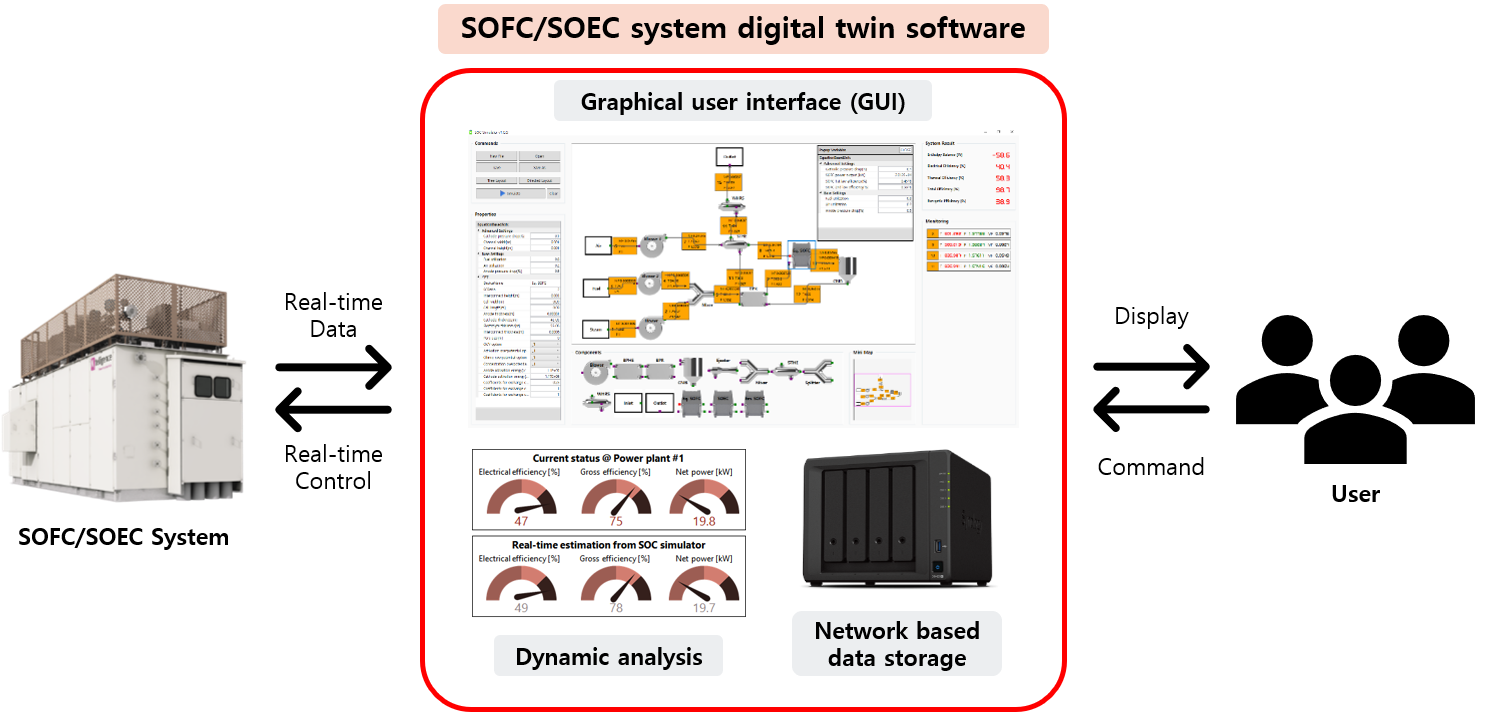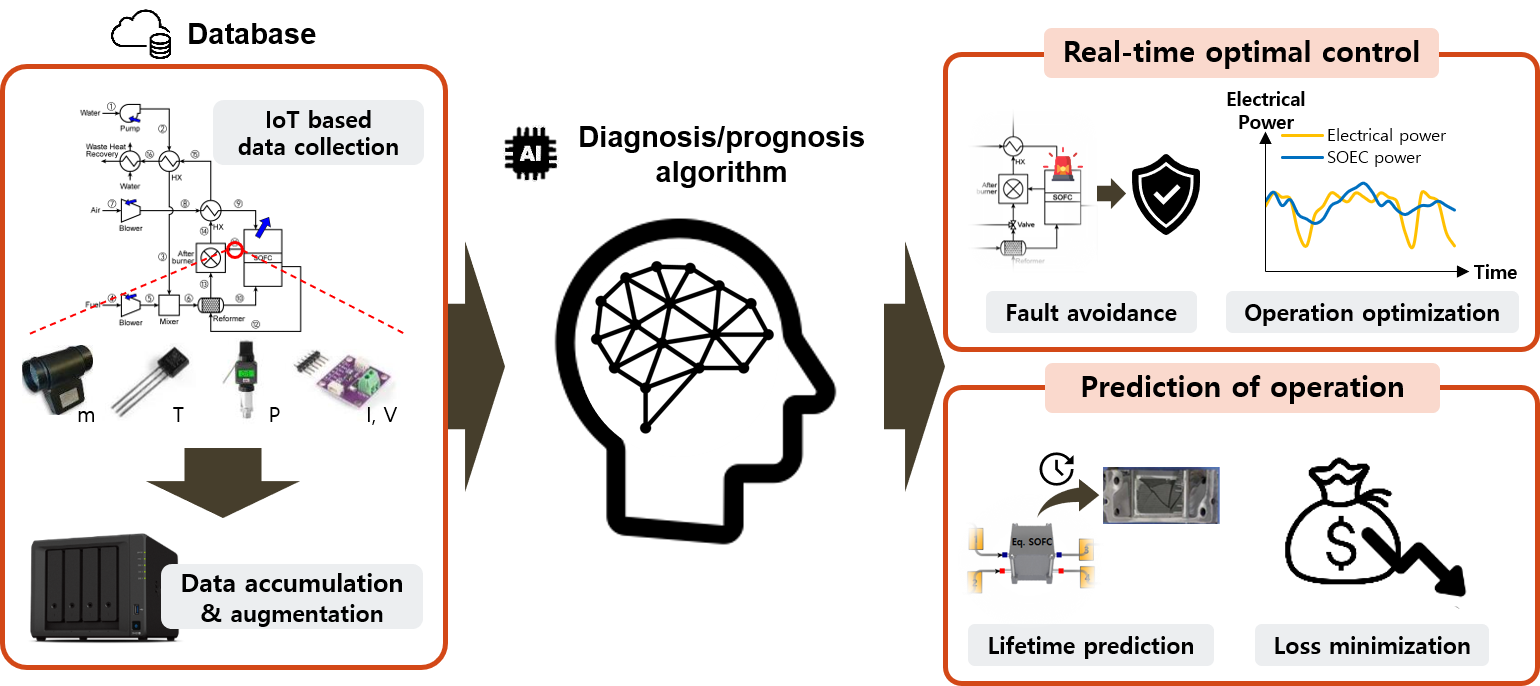Thermodynamic system engineering
As the environmental crisis induced by greenhouse gases emissions arises, there have been a great deal of discussions of reducing the emission and development of renewable energy systems. One of the promising frameworks is to develop a hydrogen-based energy grid, which does not emit carbons during the power generation, making a complete carbon-neutral process. Solid oxide fuel cell (SOFC) and solid oxide electrolytic cell (SOEC) systems could play a major role in a hydrogen-based energy grid with high efficiency and ability of heat recuperation. Until now, most of the research has focused on materials/cells/stack level analysis. Even though these studies are important for making high-efficiency energy systems, they cannot make the systems to be commercialized and deployed to society. To commercialize the systems, it is imperative to investigate their performance characteristics and improve thermodynamic and economic efficiency. Moreover, management techniques must be developed for safe, optimal, and long-term operation of the systems.

1. System component model development
System components, including SOFC/SOEC stack and balance of plant (BoP), compose the system, and their reliable modeling leads to reliable results of system simulation. However, in previous system-level studies, they have adopted numerical models with too many assumptions (e.g. constant diffusivity, fixed temperature drop, and fixed pressure-drop). Moreover, some models estimate performance stringently based on the empirical data (e.g. current-voltage curve), which makes it hard to estimate precise performance under diverse conditions. Lastly, some accurate models required too much computational resources, which makes them not suitable for real-time system analysis. As a solution, we develop high-fidelity, versatile, and fast-calculating models by adopting reliable reduced-order correlations of chemical reaction kinetics, heat and mass transfer phenomena, and fluid dynamics. Furthermore, our models adopt design variables of each component, making it possible to be validated with results obtained from actual apparatus, guaranteeing accurate performance estimation.
Main topic
: reduced-order system component modeling
References
[1] Park et al. Energy Conversion and Management, 182 (2019) 351.
[2] Min et al. Energy Conversion and Management, 209 (2020) 112614.

2. System layout design and performance optimization
When designing thermodynamic systems, it is essential to optimize thermal integration between system components. The MES laboratory designs systematically potential system layouts based on thermal integration methods and screens out system layouts that show thermodynamic infeasibility using techniques such as T-Q diagram analysis. Comparing the performances of surviving layouts, we develop highly optimized SOFC-CHP systems and SOEC co-electrolysis systems. Our expertise in system analysis not only lies on the SOFC and SOEC hybridized systems, but also on the future-generation power plants (e.g. oxy-fuel combustion cycles) and other electrochemical systems. Based on the designed system layout, the MES laboratory conducts thermodynamic and techno-economic optimization. Parametric study and sensitivity analysis are performed to evaluate the effect of operating parameters, then optimal operating conditions of the system are obtained. Moreover, we plan to evaluate the economic feasibility of the SOFC/SOEC systems. Techno-economic assessment and optimization of the designed system will be conducted regarding economic and political factors.
Main topic
: Thermodynamic system layout design
: Thermodynamic & techno-economic optimization
References
[1] Park et al. Energy Conversion and Management, 182 (2019) 351.
[2] Min et al. Energy Conversion and Management, 225 (2020) 113381.
[3] Hong et al. Energy, 34(9) (2009) 1332.
[4] Kim et al. (Under review)
[5] Kim et al. (In preparation)


3. Development of digital twin software synchronized with real system
Unlike the simulation environment, operating conditions varies and fluctuates in the industrial field. The MES laboratory develops a digital twin (MESL Digital Twin) that provides a neat solution to this problem. With the experimental data obtained from in-house stack testing setup, MESL Digital Twin provides high-fidelity estimation. Furthermore, dynamic analysis aided by quick calculation enables real-time feedback to the system with low computational cost. Implementation of user-friendly graphical user interface (GUI) visualizes the system and makes it possible to interact with the system conveniently. Based on the user-input operating protocols, it controls systems’ operating conditions autonomously. The data obtained from the MESL Digital Twin is accumulated to the MESL database, which will be used for AI-based learning for enhancing system lifetime and durability.
Main topic
: Development of MESL Digital Twin software

4. AI-based system condition diagnosis/prognosis and system control
One step forward, we aim to develop real-time system management algorithms and prognostics powered by artificial intelligence using MESL Digital Twin. By running real systems, we gather databases to train AI algorithms. Through machine learning, AI algorithms can diagnose and prognose systems’ status with data given from IoT based sensors, which will eventually provide optimal control of the systems and evade malfunctions or failures of the systems. This technology enables the precise estimation of the system’s lifetime, thereby decreasing any losses from it.
Main topic
: AI-based machine learning for system condition prediction

